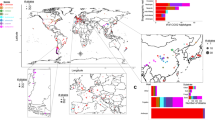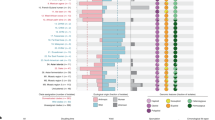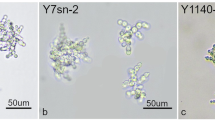Abstract
Identifying the mechanisms of eukaryotic genome evolution by comparative genomics is often complicated by the multiplicity of events that have taken place throughout the history of individual lineages, leaving only distorted and superimposed traces in the genome of each living organism. The hemiascomycete yeasts, with their compact genomes, similar lifestyle and distinct sexual and physiological properties, provide a unique opportunity to explore such mechanisms. We present here the complete, assembled genome sequences of four yeast species, selected to represent a broad evolutionary range within a single eukaryotic phylum, that after analysis proved to be molecularly as diverse as the entire phylum of chordates. A total of approximately 24,200 novel genes were identified, the translation products of which were classified together with Saccharomyces cerevisiae proteins into about 4,700 families, forming the basis for interspecific comparisons. Analysis of chromosome maps and genome redundancies reveal that the different yeast lineages have evolved through a marked interplay between several distinct molecular mechanisms, including tandem gene repeat formation, segmental duplication, a massive genome duplication and extensive gene loss.
This is a preview of subscription content, access via your institution
Access options
Subscribe to this journal
Receive 51 print issues and online access
$199.00 per year
only $3.90 per issue
Buy this article
- Purchase on SpringerLink
- Instant access to full article PDF
Prices may be subject to local taxes which are calculated during checkout






Similar content being viewed by others
References
Goffeau, A. et al. Life with 6000 genes. Science 274, 563–567 (1996)
The C. elegans Sequencing Consortium. Genome sequence of the nematode C. elegans: a platform for investigating biology. Science 282, 2012–2018 (1998)
Amanatides, P. G. et al. The genome sequence of Drosophila melanogaster. Science 287, 2185–2195 (2000)
The Arabidopsis Genome Initiative. Analysis of the genome sequence of the flowering plant Arabidopsis thaliana. Nature 408, 796–815 (2000)
International Human Genome Sequencing Consortium. Initial sequencing and analysis of the human genome. Nature 409, 860–921 (2001)
Holt, R. A. et al. The genome sequence of the malaria mosquito Anopheles gambiae. Science 298, 129–149 (2002)
Aparicio, S. et al. Whole-genome shotgun assembly and analysis of the genome of Fugu rubripes. Science 297, 1301–1310 (2002)
Stein, L. D. et al. The genome sequence of Caenorhabditis briggsae: A platform for comparative genomics. PLoS Biol. 1, 166–192 (2003)
Stephen, A. et al. A draft sequence of the rice genome (Oryza sativa L. ssp. japonica). Science 296, 92–100 (2002)
Yu, J. et al. A draft sequence of the rice genome (Oryza sativa L. ssp. indica). Science 296, 79–92 (2002)
Galagan, J. E. et al. The genome sequence of the filamentous fungus Neurospora crassa. Nature 422, 857–868 (2003)
Wood, V. et al. The genome sequence of Schizosaccharomyces pombe. Nature 415, 871–880 (2002)
Souciet, J. L. et al. Genomic exploration of the hemiascomycetous yeasts. FEBS Lett. 487, 3–147 (2000)
Kellis, M., Patterson, N., Endrizzi, M., Birren, B. & Lander, E. S. Sequencing and comparison of yeast species to identify genes and regulatory elements. Nature 423, 241–254 (2003)
Cliften, P. et al. Finding functional features in Saccharomyces genomes by phylogenetic footprinting. Science 301, 71–76 (2003)
Dietrich, F. S. et al. The Ashbya gossypii genome as a tool for mapping the ancient Saccharomyces cerevisiae genome. Science 304, 304–307 (2004)
Kellis, M., Birren, B. W. & Lander, E. S. Proof and evolutionary analysis of ancient genome duplication in the yeast Saccharomyces cerevisiae. Nature 428, 617–624 (2004)
Marck, C. & Grosjean, H. tRNomics: analysis of tRNA genes from 50 genomes of Eukarya, Archaea, and Bacteria reveals anticodon-sparing strategies and domain-specific features. RNA 8, 1189–1232 (2002)
Soonhammer, E. L. & Koonin, E. V. Orthology, paralogy and proposed classification for paralog subtypes. Trends Genet. 18, 619–620 (2002)
Mouse Genome Sequencing Consortium. Initial sequencing and comparative analysis of the mouse genome. Nature 420, 520–562 (2002)
Dehal, P. et al. The draft genome of Ciona intestinalis: insights into chordate and vertebrate origins. Science 298, 2157–2167 (2002)
Brown, C. J., Todd, K. M. & Rosenzweig, R. F. Multiple duplications of yeast hexose transport gene in response to selection in a glucose-limited environment. Mol. Biol. Evol. 15, 931–942 (1998)
Lalo, D., Stettler, S., Mariotte, S., Slonimski, P. P. & Thuriaux, P. Two yeast chromosomes are related by a fossil duplication of their centromeric regions. C. R. Acad. Sci. III 316, 367–373 (1993)
Wolfe, K. H. & Shields, D. C. Molecular evidence for an ancient duplication of the entire yeast genome. Nature 387, 708–713 (1997)
Wong, S., Butler, G. & Wolfe, K. H. Gene order evolution and paleopolyploidy in hemiascomycete yeasts. Proc. Natl Acad. Sci. USA 99, 9272–9277 (2002)
Koszul, R., Caburet, S., Dujon, B. & Fischer, G. Eucaryotic genome evolution through the spontaneous duplication of large chromosomal segments. EMBO J. 23, 234–243 (2004)
Fischer, G., Neuveglise, C., Durrens, P., Gaillardin, C. & Dujon, B. Evolution of gene order in the genomes of two related yeast species. Genome Res. 11, 2009–2019 (2001)
Fraser, H. B., Hirsh, A. E., Steinmetz, L. M., Scharfe, C. & Feldman, M. W. Evolutionary rate in the protein interaction network. Science 296, 750–752 (2002)
Kurtzman, C. P. & Fell, J. W. The Yeasts, a Taxonomic Study 4th edn (Elsevier, Amsterdam, 1998)
Frangeul, L. et al. CAAT-Box. Contigs-Assembly and Annotation Tool-Box for genome sequencing projects. Bioinformatics 20, 790–797 (2004)
Bon, E. et al. Molecular evolution of eukaryotic genomes: hemiascomycetous yeast spliceosomal introns. Nucleic Acids Res. 31, 1121–1135 (2003)
Enright, A. J., Van Dongen, S. & Ouzounis, C. A. An efficient algorithm for large-scale detection of protein families. Nucleic Acids Res. 30, 1575–1584 (2002)
Vandepoele, K., Saeys, Y., Simillion, C., Raes, J. & Van De Peer, Y. The automatic detection of homologous regions (ADHoRe) and its application to microcolinearity between Arabidopsis and rice. Genome Res. 12, 1792–1801 (2002)
Bader, G. D., Betel, D. & Hogue, C. W. BIND: the Biomolecular Interaction Network Database. Nucleic Acids Res. 31, 248–250 (2003)
Acknowledgements
We thank M. Tichit, S. Duthoy, S. Ferry and N. Zidane for technical assistance; A. Louis for help and expertise in the use of the INFOBIOGEN computational facilities; O. Jaillon, H. Roest-Crollius and their colleagues for sharing unpublished results on Tetraodon negroviridis; and A. Goffeau, H. Feldmann, A. Nicolas, N. Huu-Vang, J.-P. Latgé, I. Moszer and M. Vergassola for discussions and advice. This work was supported by the Consortium National de Recherche en Génomique (to Génoscope and to Institut Pasteur Génopole), the CNRS (GDR 2354, Génolevures sequencing consortium) and the ‘Conseil Régional d'Aquitaine’. B.D. is a member of Institut Universitaire de France.
Author information
Authors and Affiliations
Corresponding authors
Ethics declarations
Competing interests
The authors declare that they have no competing financial interests.
Supplementary information
Supplementary Table S1
List of centromeres for C. glabrata, K. lactis and Y. lipolytica with coordinates, sequences and flanking genes. (PDF 141 kb)
Supplementary Table S2
List of telomeric repeats and proteins of the telomerase complex of C. glabrata, K. lactis, D. hansenii and Y. lipolytica. (PDF 70 kb)
Supplementary Table S3
Full table of codon usage and number of tRNA genes in S. cerevisiae, C. glabrata, K. lactis, D. hansenii and Y. lipolytica. (PDF 147 kb)
Supplementary Table S4
Full list of introns in tRNA genes of S. cerevisiae, C. glabrata, K. lactis, D. hansenii and Y. lipolytica with their size (in nucleotides). (PDF 102 kb)
Supplementary Table S5
List of potentially co-transcribed tRNA gene pairs in C. glabrata, K. lactis, D. hansenii and Y. lipolytica with nature of gene involved, size of intergene and number of occurences in each genome. (PDF 63 kb)
Supplementary Table S6
List of all identified non-coding RNA genes in C. glabrata, K. lactis, D. hansenii and Y. lipolytica, with type, size of molecules, gene name, and chromosomal location. (PDF 70 kb)
Supplementary Figure S7
Phylogenetic tree of Hemisaacomycete yeast species derived from 25S rDNA sequences. (PDF 91 kb)
Supplementary Table S8
Full list of genes encountered in tandem arrays in any of the yeasts S. cerevisiae, C. glabrata, K. lactis, D. hansenii and Y. lipolytica with indication of gene number, protein family number and functional annotation. (PDF 137 kb)
Supplementary Table S9
A list of all recognized ancient duplication blocks in the genome of C. glabrata, with the names of paralogous gene duplicates involved, their map coordinates, and the corresponding ancient duplication blocks in the genome of S. cerevisiae, when coinciding. (PDF 82 kb)
Supplementary Table S10
List of S. cerevisiae genes with their functional annotation which are specifically absent in only one of the four yeast species C. glabrata, K. lactis, D. hansenii and Y. lipolytica (but present in the three others). (PDF 111 kb)
Supplementary Table S11
List of genes identified in the genomes of K. lactis, D. hansenii and Y. lipolytica, without homolog in other eucaryotes, including other yeasts and that probably correspond to horizontal gene transfer from bacterial origin. (PDF 108 kb)
Supplementary Methods S12
Details the successive steps followed in the classifiaction of the 34,824 proteins of S. cerevisiae, C. glabrata, K. lactis, D. hansenii and Y. lipolytica. (PDF 91 kb)
Rights and permissions
About this article
Cite this article
Dujon, B., Sherman, D., Fischer, G. et al. Genome evolution in yeasts. Nature 430, 35–44 (2004). https://doi.org/10.1038/nature02579
Received:
Accepted:
Issue Date:
DOI: https://doi.org/10.1038/nature02579
This article is cited by
-
‘Mother(Nature) knows best’ – hijacking nature-designed transcriptional programs for enhancing stress resistance and protein production in Yarrowia lipolytica; presentation of YaliFunTome database
Microbial Cell Factories (2024)
-
Bidirectional hybrid erythritol-inducible promoter for synthetic biology in Yarrowia lipolytica
Microbial Cell Factories (2023)
-
Candida diagnostic techniques: a review
Journal of Umm Al-Qura University for Applied Sciences (2023)
-
Genetic Diversity of Human Fungal Pathogens
Current Clinical Microbiology Reports (2023)
-
Molecular basis of cycloheximide resistance in the Ophiostomatales revealed
Current Genetics (2022)



